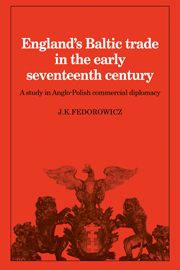 England's Baltic Trade in the Early Seventeenth Century
England's Baltic Trade in the Early Seventeenth Century Book contents
- Frontmatter
- Contents
- Preface
- List of maps and graphs
- List of abbreviations
- Map
- Introduction
- 1 English perceptions of the Polish Commonwealth
- 2 The mechanics of English diplomacy in the Eastland
- 3 The early history of the Eastland Staple at Elbing
- 4 The operation of the staple
- 5 The pattern of English shipping into the Baltic
- 6 English exports to the Baltic
- 7 English imports from the Baltic
- 8 The threat to the Eastland Staple at Elbing
- 9 The depression of 1620 and the crisis of England's Baltic trade
- 10 The political crisis, 1620–9
- 11 The mission of Sir Thomas Roe to the Eastland
- 12 Attempts at reconciliation with Danzig, 1630–5
- 13 The climax of English commercial diplomacy, 1635–42
- 14 Conclusion
- Notes
- Bibliography
- Index
7 - English imports from the Baltic
Published online by Cambridge University Press: 05 November 2011
- Frontmatter
- Contents
- Preface
- List of maps and graphs
- List of abbreviations
- Map
- Introduction
- 1 English perceptions of the Polish Commonwealth
- 2 The mechanics of English diplomacy in the Eastland
- 3 The early history of the Eastland Staple at Elbing
- 4 The operation of the staple
- 5 The pattern of English shipping into the Baltic
- 6 English exports to the Baltic
- 7 English imports from the Baltic
- 8 The threat to the Eastland Staple at Elbing
- 9 The depression of 1620 and the crisis of England's Baltic trade
- 10 The political crisis, 1620–9
- 11 The mission of Sir Thomas Roe to the Eastland
- 12 Attempts at reconciliation with Danzig, 1630–5
- 13 The climax of English commercial diplomacy, 1635–42
- 14 Conclusion
- Notes
- Bibliography
- Index
Summary
The general structure of imports
Any attempt to reconstruct the nature of English imports from the Baltic is considerably facilitated by the fact that the STT contains ports of lading for westbound cargo. This makes it possible to follow shifts in England's commercial relationship with various Baltic ports, something impossible to discern from the STT records of English exports. The general method employed in this chapter will demonstrate the increase in English importation from the Baltic of non-Polish products during the course of the seventeenth century; the STT offers clear evidence that English merchants increasingly imported their most important return commodities from those Baltic areas under Swedish control.
In attempting to evaluate the STT records it is possible to compare them with the evidence of extant port books from Poland. The EPB constitute a particularly valuable series in this respect and it is hoped that such a systematic comparison may be undertaken at some stage in the future. Though such an analysis is beyond the scope of this present work, a tentative comparison of data from the two sources for the year 1585, selected at random, indicates the extent of the problem and offers a mixture of disappointment and satisfaction. Totals for the year for nine major commodities have been compiled in table 7.1. In most cases the totals given in the STT are higher than those recorded as leaving Elbing, and this can probably be accounted for by additional lading at Königsberg.
- Type
- Chapter
- Information
- England's Baltic Trade in the Early Seventeenth CenturyA Study in Anglo-Polish Commercial Diplomacy, pp. 102 - 131Publisher: Cambridge University PressPrint publication year: 1980


